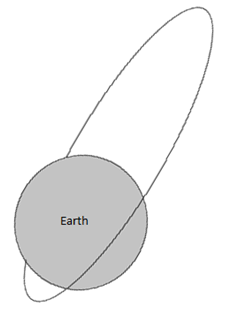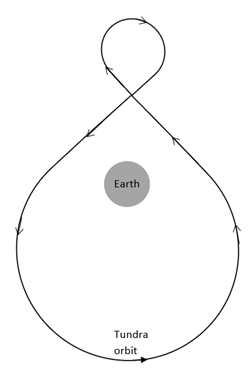This set of Spaceflight Mechanics Multiple Choice Questions & Answers (MCQs) focuses on “Interplanetary Trajectories – Critical Inclination & Special Orbit Types”.
1. At which angle is the orbit critically inclined?
a) 63.4 deg
b) 116.6 deg
c) 63.4 deg and 116.6 deg
d) 90 deg
View Answer
Explanation: When the inclination of the orbit is 63.4 deg and 116.6 deg, the orbit is known to be critically inclined. At these angles the apse line which is an imaginary line joining the two apsides does not move.
2. Why are critically inclined orbits preferred for space missions?
a) Least deviations of eccentricity and argument of pericenter
b) Less velocity impulse required
c) Less time-period of the orbit
d) Less energy for orbital transfer
View Answer
Explanation: The critically inclined orbits have been of interest in artificial satellite theory. They have the lest deviations of eccentricity and argument of periapsis from the initial values. This makes it preferential for space missions.
3. Which of these terms is dominant in critically inclined orbit?
a) J3 Harmonic of central body
b) Earth’s oblateness term J2
c) J4 Perturbation term
d) J5 Perturbation term
View Answer
Explanation: The critical inclinations’ primary assumption is that the oblateness term J2 is dominant over other harmonic coefficients: J3, J4, J5. This assumption is valid only for large celestial bodies such as Earth, Mars, Moon etc.
4. Which of these is an example of critically inclined orbit?
a) MEO
b) LEO
c) Molniya orbit
d) Polar orbit
View Answer
Explanation: Molniya orbit is an example of critically inclined orbit. It is highly eccentric and highly elliptical orbit which has an inclination of 63.4 degrees.

5. Which of these orbits form a highly inclined figure 8 form?
a) Molniya Orbit
b) Tundra Orbit
c) Sun-Synchronous Orbit
d) Polar Orbit
View Answer
Explanation: Tundra orbit is a type of Geosynchronous orbit which has a very high inclination of 63.4 degrees with a low eccentricity of range 0.2-0.3. The orbit is of figure 8 form with one of the smaller loops in either of the hemisphere. Compared to Molniya orbit, this has half the orbital time period.

6. How many satellites are required in Tundra orbit to provide continuous communication?
a) 1
b) 2
c) 3
d) 4
View Answer
Explanation: Due to its highly eccentric orbit, satellites in Tundra orbit stay in high-latitude region for longer time periods of the time at apogee. Two satellites are required in Tundra orbit to provide continuous communication with earth’s receiving communication end.
7. How many satellites are required in Molniya orbit to provide continuous communication?
a) 1
b) 2
c) 3
d) 4
View Answer
Explanation: Due to its highly eccentric orbit, satellites in Tundra orbit stay in high-latitude region for longer time periods of the time at apogee. Two satellites are required in Tundra orbit to provide continuous communication with earth’s receiving communication end.
8. What is the formula used to find the rate of change of argument of perigee for critically inclined orbit?
a) \(\dot{\omega} = \frac{3}{4}\) nJ2 \(\Big(\frac{R_E}{a}\Big)^2 \frac{(4 – 5 sin^2 i)}{(1-e^2)^2}\)
b) \(\dot{\omega} = \frac{1}{4}\) nJ3 \(\Big(\frac{R_E}{a}\Big)^2 \frac{(4 – 5 cos^2 i)}{(1-e^2)^2}\)
c) \(\dot{\omega} = \frac{3}{4}\) nJ2 \(\Big(\frac{R_E}{a}\Big)^2 \frac{(1-e^2)^2}{(4 -5sin^2 i)}\)
d) \(\dot{\omega} = \Big(\frac{R_E}{a}\Big)^2 \frac{(4 – 5 sin^2 i)}{(1-e^2)^2}\)
View Answer
Explanation: For a critically inclined orbit, the earth’s oblateness factor J2 plays the integral role to perturb satellite’s rate of change of argument of perigee.
Where, i is inclination
e is eccentricity
J2 is perturbing factor
RE is the radius of earth
In case of Tundra or Molniya orbit (4 – 5sin2 i) term becomes zero as they are inclined at an angle of 63.4 deg. Thus there is no change in the perigee position with time.
9. What is the variant of Tundra orbit called which has a teardrop shape instead of the figure 8 shape?
a) Teardrop Tundra orbit
b) Supertundra orbit
c) Semi tundra orbit
d) Variant tundra orbit
View Answer
Explanation: The Tundra orbit is a highly elliptical and critically inclined orbit which makes a figure-8 shape. A variant of this orbit is called Supertundra orbit which instead of figure-8 makes a teardrop shape.
10. What is the orbital period of Molniya orbit?
a) One-third the sidereal day
b) Half the sidereal day
c) Twice the sidereal day
d) Three- fourth the sidereal day
View Answer
Explanation: For the geometry of the ground track of Molniya orbit to repeat after every 24 hours, the time period has to be half of the sidereal day to keep longitudes of the apogee constant.
Sanfoundry Global Education & Learning Series – Spaceflight Mechanics.
To practice all areas of Spaceflight Mechanics, here is complete set of 1000+ Multiple Choice Questions and Answers.
If you find a mistake in question / option / answer, kindly take a screenshot and email to [email protected]
